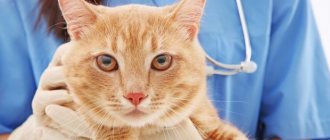Animals experience stress just like people, and often to a greater extent. The environment, unexplained events, and a banal move can have a detrimental effect on the pet, as they are difficult to withstand nervous overload.
Stress in a cat, like stress in a cat, is not always noticeable, since these animals are able to suppress their emotional state and not show off their fears and worries with dignity. Therefore, the owner’s task is to know the behavior of his pet down to the smallest detail in order to notice oddities in behavior in time and provide support and the necessary assistance.
Causes of stress
Sometimes stress is caused by serious reasons, sometimes by very minor ones, for example, buying a new litter. Let's name the most common ones:
- moving or renovation - a new place of residence confuses the animal and makes it very nervous, as does the fuss during renovation;
- jealousy - manifests itself towards a new family member, a newborn child or a new pet. The cat thinks that the newcomer is encroaching on his personal territory and stealing the attention of his beloved owner;
- malaise - a cat constantly suffering from pain or the consequences of injury, is stressed, afraid and worried;
- emotional shock - a long departure or death of the owner provokes severe stress.
Also, a stressful condition in cats can be caused by a trip to the veterinarian, a change in the daily routine, or rearrangement of furniture. Obesity contributes to constant stress. If you change the usual feeding schedule, you will also make the cat worry.
Cystitis
Treating cystitis in cats is quite difficult. First of all, she needs to create favorable conditions, relieve her of stress and drafts.
The place where she sleeps should always be warm and dry. The diet should be special, in which the amount of salt and protein should be reduced.
How stress manifests itself
In order to provide timely help to your pet, you need to know how stress manifests itself. The symptoms of this phenomenon are not always easy to recognize, especially if you do not know much about animal psychology. Pay attention to the cat's behavior. Perhaps he:
- licks himself excessively, so that the consequences in the form of scratches and bald spots remain on the skin;
- yawns constantly;
- has sharply changed food habits, shows excessive appetite or has started gnawing on inedible things;
- constantly follows you and meows or simply nervously moves around the territory;
- tries to isolate himself by choosing dark places.
Pay attention to the condition of the cat's fur. Under stress, it worsens significantly - it fades and falls out. A stressed animal may lose its usual interest in keeping its coat clean.
Toilet problems will indicate a stressful state. One of the main warning signs is difficulty urinating. The reason is stress hormones, which cause inflammation of the bladder. Hence the physical manifestations of extreme anxiety and excitement. If the cat is clearly uncomfortable going to the litter box, he does it too often, he walks by, or there is blood in his urine - these are alarming symptoms. Diarrhea sometimes indicates stress.
Symptoms
It's not easy to spot signs of stress in your pet. Every cat behaves differently when stressed. Typical symptoms may be:
- Excessive licking;
- The animal begins to avoid communication with people and hides in places where it is difficult to reach;
- Loss of appetite;
- Ignoring the tray;
- Aggression.
Cats are one of the most secretive animals, so you need to be a very observant owner to spot signs of stress in your pet.
Why does your pet need help?
The harmful effects of stress on a cat’s body cannot be underestimated. External events provoke overstrain of the nervous system, which affects not only the cat’s behavior, but also its health. Internal organs begin to fail.
There is a distinction between long-term and short-term stress. The latter is caused by minor changes in the animal’s life and often goes away without consequences. Long-term stress is more dangerous, as it gradually damages the body more and more, and the cat gets sick. The immune system suffers, the pet can easily catch an infectious disease. The consequences of stress are the appearance of skin diseases, hypertension, and increased blood sugar. This will be noticeable in the tests if you go to the veterinarian for examination.
There are three stages in the development of stress:
- in the first stage you usually don't notice anything. But you can see how the pet has become apathetic or, on the contrary, overly excitable. Changes may also affect nutrition: the cat eats much more than usual or refuses food altogether. This stage is characterized by a decrease in pressure and temperature, a decrease in body tone, and rapid breathing;
- at the second stage, the cat adapts to the situation, recovers and calms down, the condition returns to normal in the absence of stimuli;
- in the third stage, exhaustion occurs if you do not eliminate the stress factor. The animal is no longer able to recover, calming down, and stops eating, sometimes even to the point of death.
To prevent something irreparable, be attentive to the cat and help on your own. If this does not work and the situation is serious, contact your veterinarian immediately.
Drug treatment
If psychological methods do not work, the veterinarian prescribes medications. The following drugs are in demand:
- Cat Baiyun;
- Stop stress;
- Fitex;
- Feliway.
cat Baiyun
The product is a mixture of phytosterols made from medicinal plants. Available in the form of infusion or tablets. The cat is infused with 2 ml (1/2 teaspoon) of the product 3-4 times a day. The course of treatment is 5–7 days. The opened bottle is stored in the refrigerator. The tablets are given in the same sequence. Cats do not tolerate violence and will fight back, so you need to be careful of their claws. The medicine is contraindicated for kittens under 10 months of age, nursing and lactating kittens.
Stop stress
The drug combines herbal extracts with Phenibut, a fear suppressant. The medicine is available in tablets or drops. One form or another of the drug is given twice a day for 2–3 weeks. Dosage: 1 drop/kg body weight or ¼ tablet per animal. Precautions and contraindications are the same as for Kot Bayun.
Stop stress
Fitex
The inconvenience is that, according to the instructions, the cat is transferred to three feedings a day, giving the medicine 3-5 drops an hour before meals three times a day. The course of treatment is 15–30 days.
Feliway
The active substance of the drug is pheromones - behavior regulators that have a calming effect. Forms of medicine: spray, collar or device resembling a fumigator. The container is connected to an outlet, the supply of liquid is enough for a month.
Feliway
What can the owner do
If you notice signs of stress in your cat, then you need to eliminate its causes. After this, the animal should return to normal. During this time, you should pay more attention to him.
The task of a cat owner who is under stress is to switch his attention and distract him from the stress factor. Offer new toys and entertainment, give tasty food.
Physical activity helps with stress. The best option is to purchase a play complex where the cat can climb, jump, and play with all sorts of devices. Consider the age and health of your pet. Physical activity must be adequate. The cat’s nervous system does not need overload to avoid an emotional breakdown.
You can relieve stress in a cat using the immersion method - simulate situations that irritate the animal. The goal is to teach him that there is nothing dangerous in them. For example, if a cat is panicking on the street, take it outside in a carrier, gradually increasing the walking time.
A stressed pet will be relaxed by the owner's attention. Pet him and massage him often. It will be useful for you too. A good method of relaxation is a pleasant smell. Aromatherapy calms animals, whose sense of smell is much better than ours. Use an aroma lamp or special incense sticks. Choose the scent of lavender, mint, cedar, bergamot. They give a sedative effect.
Try different methods of getting rid of stress, taking into account the reasons that caused it. A combination of several methods may be required. You will understand what is right for your cat only through practice.
Adjust your animal's diet when stressed. Sea fish, vegetable oil, eggs, and fish oil will be beneficial for the nervous system. Choose ready-made food containing fatty acids.
Chronic appearance
The chronic type of stress does not develop over a short period of time, so it is much more difficult to notice.
A cat that experiences chronic stress: loses appetite, ignores the litter box, hides, jumps at any noise, stops playing, eats its fur, and begins to give conflicting signals.
Moving a cat to a new apartment
Moving is a stressful situation not only for you, but also for your pets. It is generally accepted that dogs tend to become more attached to their owners, but cats tend to become more attached to their familiar territory. Therefore, as a rule, cats are more acutely worried about changes in their place of residence. In this material, we have prepared tips and simple rules for you, by listening to which you can minimize your pet’s stress from moving to a new apartment.
Preparation should begin in advance
.
- Important point. You'll probably find yourself using a carrier bag on moving day. This is correct - this way the cat will definitely not be able to escape from your hands, scared, and run away. However, if you have not used a carrier before, then take care in advance to accustom your cat to it. It's better to start in a couple of weeks. Leave the carrier open and within your pet's reach. Place toys, bedding, and a bowl of food inside. This is necessary to evoke positive associations in the animal.
- Moving often involves repairs and other noisy work - drilling, hanging shelves, assembling and installing furniture. Try to organize everything so that by the time the cat arrives in the house, all such work will be completed.
- Walk around the new house in advance and identify all the hard-to-reach places where your pet might try to hide. Cover or somehow block the animal's access to various gaps, crevices, niches under the bathtub or behind a cabinet.
- Don’t be lazy and make a list in advance of those things that you will need to organize a familiar and safe space for your pet immediately after the move. Otherwise, there is a risk of packing the necessary items in different boxes and simply not finding them among all the things when the need arises. Include a set of bowls, food, litter tray, toys, and veterinary supplies. Pack all these items separately and be sure to label the box properly.
________
Especially for this article, we conducted a short interview with a veterinarian who gave his recommendations. Ksenia Yuryevna Osipova, veterinarian, head of the on-call veterinary service Vetmobile, Moscow, answered our questions
1. Should I give my cat any medications in preparation for moving?
The answer is unequivocal - yes. For most cats, a change of shelter, especially if she usually does not leave the apartment, is very stressful. Due to the resulting stress, a cat may develop a disease such as idiopathic cystitis. And in some cats, due to stress, pulmonary edema may occur within a week after experiencing stress, even in the absence of concomitant heart disease. What can we say about older cats (over 7 years old). For them, stress can serve as an impetus for the exacerbation of chronic processes, which previously could have been hidden and not manifested in any way. So how can we help? There are several ways to do this. The first is the use of phenibut-based drugs for animals in the form of drops or tablets (for example, “Stop-Stress”). It is necessary to start taking them 3-4 days before moving, since the effect is cumulative. The second method is cat pheromones (for example, “Feliway”, “Relaxivet”). These drugs have several forms of release. This includes a collar, a diffuser (a device with liquid, similar to the one we use against mosquitoes, that is inserted into an outlet), and drops on the withers (especially suitable for cats who find it difficult to give the drug by mouth), and a spray. The spray can be used to treat the carrier in which the cat will be transported, and the diffuser will be convenient to use in the new room. The hormones that are part of these drugs calm and give a feeling of safety to the cat, helping to quickly get used to new surroundings, sounds and smells.
2. How to feed the cat during this period?
Quite often, cats get sick in the car and may vomit. To reduce the risk of this problem, remove your pet's food 6 hours before moving (you can leave the water). Once the cat is in its new home, you can immediately offer it food. Don't worry if during the first 24 hours your cat refuses to eat and prefers to hide somewhere secluded. Although, as practice shows, not only people eat stress. Most cats will also choose to eat after moving. It is only advisable that the cat’s bowls move with it, and the cat is offered its usual diet. You can also pamper your cat with something he especially loves - wet food, treats, etc.
3. What else to consider?
Trim your cat's nails before moving. Because cats that are not accustomed to leaving the house and being in a carrier will try to break out and in the course of these attempts they can tear off their claws. In the car, make sure your cat is not too hot in the carrier. Take water with you and, if necessary, offer your pet a drink. ________
Note! We recommend that anyone preparing to move with their pets consult with a veterinarian you trust. Let the health of your animals be under the control of professionals!
On the day of the move.
Moving is a troublesome business. People are scurrying around the house, everyone is carrying something, and tape is making noise as the last boxes are being packed. And while loading things from the apartment into the car, the doors are also constantly open. And then everything is the same in the new apartment - unlocked doors, noise, bustle, strangers. For a cat, such an environment will definitely be extremely unpleasant. In addition, there is a great risk that she may find herself unattended and simply run away, escaping noise and stress. So here are our tips:
- It is optimal if you figure out in advance where your pet will wait out the move - perhaps you can leave him for a day or a couple of days with friends or relatives.
- If the presence of a cat in the apartment during the move cannot be ruled out, then worry about its safety. Lock the cat in a room where there will be all the things it needs - a tray, bowls, toys. Do not allow the cat to move freely around the apartment - it may get scared, run away, hide, or simply get in the way.
- Isn’t it possible to give your cat a whole room? You can isolate him using a spacious carrier or cage. It is important to accustom your pet to this “house” in advance so that he feels as comfortable as possible. To place the carrier on moving day, choose the quietest place in the apartment.
- Be sure to talk to your pet. Cats are great at picking up and distinguishing intonations, so it’s not so important what exactly you say. The main thing is to maintain a calm, friendly tone.
- Please don't be superstitious. You should not make a cat a victim of omens and force it into the house first. When you find yourself in a new apartment, simply open the carrier and let the animal explore the territory in comfort.
- When your pet is ready and leaves the carrier, show him where his bowls and litter tray are now. It is important that the cat always has free access to water! When it comes to feeding, it is best to follow your veterinarian's recommendations. In any case, the first feeding after the experience of moving may not be too abundant, moderate
.
After the move.
The main test and extreme stress are over, but you should help your pet adapt to new conditions. It is not difficult:
- Use familiar bowls and an old tray. It’s better to pamper your pet with new clothes a little later.
- The same applies to the daily routine. Continue with your regular schedule and feed your pet at the same time.
- Try to pay more attention to the cat at least at first. Feeling your care and support, the animal will get used to its new home much faster.
We think you have noticed how sensitively our little friends react to our mood and experiences.
Therefore, the main condition for a pet’s peace of mind is the mood of its owner. Yes, moving can be stressful. Seeing your worries, the cat will not be able to remain indifferent; it will be nervous, which may even affect its well-being. Do you want to organize your move so that all family members, including pets, remain comfortable? Consider leaving most of the hassle to professional movers. Specialists are happy to help. We will carefully pack items, even delicate items such as cat bowls or toys. We will disassemble the furniture and prepare equipment for transportation. And in the new house we’ll put everything in its place, install a cat house or a scratching post against the wall. And we’ll even help you unpack and organize your things, if necessary. No worries or worries, all you have to do is monitor the pet’s condition and choose the best place for its bed. And moving a cat to a new home will be easy and painless.










